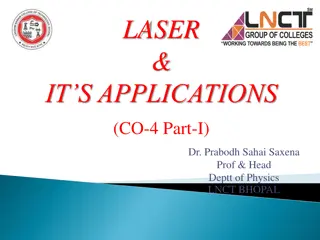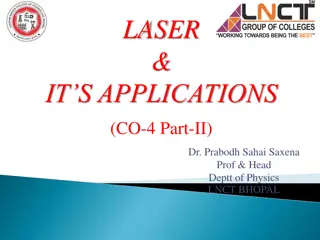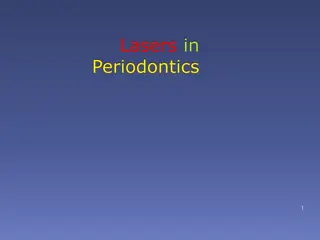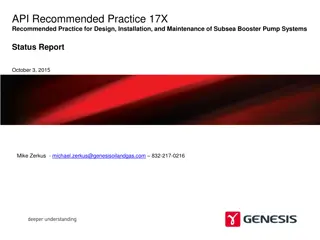Types of Pumping Sources in Lasers
Depending on the type of laser, various pumping methods are used including optical pumping, electric discharge pumping, chemical pumping, and heat pumping. Optical pumping utilizes light energy to achieve population inversion in the laser medium, while electric discharge pumping involves passing high voltage electric discharge through the medium. Chemical reactions can also generate excited atoms or molecules for pumping. Each method contributes to achieving population inversion necessary for laser operation.
Download Presentation

Please find below an Image/Link to download the presentation.
The content on the website is provided AS IS for your information and personal use only. It may not be sold, licensed, or shared on other websites without obtaining consent from the author. Download presentation by click this link. If you encounter any issues during the download, it is possible that the publisher has removed the file from their server.
E N D
Presentation Transcript
Types of pumping source in lasers Depending upon the type of laser, the most commonly used pumping methods are listed below: a) Optical pumping: In this, the population inversion is achieved by means of light energy delivered from appropriate pumping source such as gaseous discharge or flash tubes. For example, in ruby laser, xenon flash tube is used. b) Electric discharge: pumping: this type of pumping accomplished by means of intense electrical discharge in the medium and is particularly suited to gas media like He-Ne laser and CO2laser. The electric discharge coverts the gas into a plasma where active centers collide inelastically with free electrons and population inversion is achieved. c) Chemical pumping: It raises active centers into the higher levels by means of suitable exothermal chemical reactions in the active medium. d) Heat pumping: In this type of pumping, the active material is first brought to a high temperature then rapidly cooled down.
Optical Pumping As the name suggests, in this method, light is used to supply energy to the laser medium. An external light source like xenon flash lamp is used to produce more electrons (a high population) in the higher energy level of the laser medium. When light source provides enough energy to the lower energy state electrons in the laser medium, they jump into the higher energy state E3. The electrons in the higher energy state do not stay for long period. After a very short period, they fall back to the next lower energy state or meta stable state E2by releasing radiation less energy. Helical shape Elliptical shape The meta stable state E2has greater lifetime than the lower energy state or ground state E1. Hence, more electrons are accumulated in the energy state E2than the lower energy state E1. Thus, population inversion is achieved. Optical pumping is used in solid-state lasers such as ruby lasers as mentioned above.
Electric Discharge or Excitation by Electrons Electric discharge refers to flow of electrons or electric current through a gas, liquid or solid. In this method of pumping, electric discharge acts as the pump source or energy source. A high voltage electric discharge (flow of electrons, electric charge, or electric current) is passed through the laser medium or gas. The intense electric field accelerates the electrons to high speeds and they collide with neutral atoms in the gas. As a result, the electrons in the lower energy state gains sufficient energy from external electrons and jumps into the higher energy state. This method of pumping is used in gas lasers such as argon lasers.
Chemical Reactions If an atom or a molecule is produced through some chemical reaction and remains in an excited state at the time of production, then it can be used for pumping. The hydrogen fluoride molecule is produced in an excited state when hydrogen and fluorine gas chemically combine. The number of produced excited atoms or molecules is greater than the number of normal state atoms or molecules. Thus, population inversion is achieved. For example, H2+ F2 2HF, in this chemical reaction, hydrogen (H2) and fluorine (F2) molecules are chemically combined to produce hydrogen fluoride molecule (2HF) in an excited state. Thermal Pumping Sometimes we can achieve population inversion by heating the laser medium. In thermal pumping, heat acts as the pump source or energy source. In this method, population inversion is achieved by supplying heat into the laser medium. When heat energy is supplied to the laser medium, the lower energy state electrons gains sufficient energy and jumps into the higher energy level.
Inelastic Atom-Atom Collisions Like the electric discharge method, here also a high voltage electric discharge acts as a pump source. However, in this method, a combination of two types of gases, say X and Y are used. The excited state of gas X is represented as X+whereas gas Y is represented as Y+. Both X and Y gases have the same excited states (X+and Y+). When high voltage electric discharge passes through a laser medium having two types of gases X and Y, the lower energy state electrons in gas X will move to the excited state X+similarly the lower energy state electrons in gas Y moves to the excited state Y+ Initially, during electric discharge, the lower energy state electrons in gas X or atom X gets excited to X+due to continuous collision with electrons. The excited state electrons in gas X+now collide with the lower energy state electrons in gas Y. As a result, the lower energy state electrons in gas Y gains sufficient energy and jump into the excited state Y+. This method is used in the Helium Neon (He-Ne) laser. .
Various Laser Resonators The most widely used laser resonators or cavities have either plane or spherical mirrors of rectangular or circular shape, separated by some distance L. There have appeared Plane Parallel Resonators, Concentric (Spherical) Resonators, Confocal Resonators, Generalized Spherical Resonators and Ring Resonators. Plane Parallel Resonator consists of two plane mirrors set parallel to each other, as shown in the figure below. The one round trip of wave in the cavity should be an integral number times 2p , the resonant frequencies is n = kc/(2L), k is an integral number, c is the speed of light in the medium, L is the cavity length. The frequency difference between two consecutive modes (possible standing wave in the cavity) is c/(2L). This difference is referred to as the frequency difference between two consecutive longitudinal modes; the word longitudinal is used because the number k indicates the number of half-wavelengths of the mode along the laser resonator, i.e., in the longitudinal direction. Concentric resonator consists of two spherical mirrors with the same radius R separated by a distance L=2R, so that the centers are coincident. The resonant frequencies use the same equation as above. Confocal resonator consists of two spherical mirrors of the same radius of curvature R separated by a distance of L such that their foci F1 and F2 coincident. In this case, the center of curvature of one mirror lies on the surface of another mirror, L=R. The resonant frequency cannot be readily obtained from geometrical optics consideration. Resonators formed by two spherical mirrors of the same radius of curvature R and separated by a distance L such that R<L<2R, i.e., inbetween confocal and concentric, are called Generalized Spherical Resonators, which is also often used. Ring Resonator is a particularly important class of laser resonators. The path of the optical rays is arranged in a ring configuration or more complicated configurations like folded configurations. We can compute the resonant frequencies by imposing the constraints that the total phase shift along the ring path or the closed loop path must be equal to the integral numbers of 2p . Then the resonant frequencies are n = kc/Lp, where k is an integral number, Lp is the loop path length.
Cavities can be identified as stable or unstable according to whether they make the oscillating beam converge into the cavity or spread out of the cavity. The output mirror of the laser resonator is finely coated to reach the required reflection into the cavity, if the beam is too intense, the mirror may suffer breakage. Breakage is serious because it causes shut down of the production. So for powers up to 2kW, lasers mainly use stable cavity designs(see figure ?a), laser output is from the center of optical axis. Stable cavity design allows the beam to oscillate many times inside the cavity to get high gain, the focal property and directionality are improved. For higher powered lasers, unstable cavities are often used (see figure ?b), laser output comes from the edge of the output mirror, which is often a totally reflecting metal mirror. The ring shaped beam reduces the intensity of the beam, thus reduces the risk of breakage. In the same time ring shaped beam is poor for focusing. Unstable cavities are suitable for high gain per round trip laser systems, which don t require large numbers of oscillation between the mirrors.






















